Anna Maria Massone
Deep Learning for Active Region Classification: A Systematic Study from Convolutional Neural Networks to Vision Transformers
Oct 23, 2024Abstract:A solar active region can significantly disrupt the Sun Earth space environment, often leading to severe space weather events such as solar flares and coronal mass ejections. As a consequence, the automatic classification of active region groups is the crucial starting point for accurately and promptly predicting solar activity. This study presents our results concerned with the application of deep learning techniques to the classification of active region cutouts based on the Mount Wilson classification scheme. Specifically, we have explored the latest advancements in image classification architectures, from Convolutional Neural Networks to Vision Transformers, and reported on their performances for the active region classification task, showing that the crucial point for their effectiveness consists in a robust training process based on the latest advances in the field.
Forecasting Geoffective Events from Solar Wind Data and Evaluating the Most Predictive Features through Machine Learning Approaches
Mar 14, 2024Abstract:This study addresses the prediction of geomagnetic disturbances by exploiting machine learning techniques. Specifically, the Long-Short Term Memory recurrent neural network, which is particularly suited for application over long time series, is employed in the analysis of in-situ measurements of solar wind plasma and magnetic field acquired over more than one solar cycle, from $2005$ to $2019$, at the Lagrangian point L$1$. The problem is approached as a binary classification aiming to predict one hour in advance a decrease in the SYM-H geomagnetic activity index below the threshold of $-50$ nT, which is generally regarded as indicative of magnetospheric perturbations. The strong class imbalance issue is tackled by using an appropriate loss function tailored to optimize appropriate skill scores in the training phase of the neural network. Beside classical skill scores, value-weighted skill scores are then employed to evaluate predictions, suitable in the study of problems, such as the one faced here, characterized by strong temporal variability. For the first time, the content of magnetic helicity and energy carried by solar transients, associated with their detection and likelihood of geo-effectiveness, were considered as input features of the network architecture. Their predictive capabilities are demonstrated through a correlation-driven feature selection method to rank the most relevant characteristics involved in the neural network prediction model. The optimal performance of the adopted neural network in properly forecasting the onset of geomagnetic storms, which is a crucial point for giving real warnings in an operational setting, is finally showed.
AI-FLARES: Artificial Intelligence for the Analysis of Solar Flares Data
Jan 02, 2024Abstract:AI-FLARES (Artificial Intelligence for the Analysis of Solar Flares Data) is a research project funded by the Agenzia Spaziale Italiana and by the Istituto Nazionale di Astrofisica within the framework of the ``Attivit\`a di Studio per la Comunit\`a Scientifica Nazionale Sole, Sistema Solare ed Esopianeti'' program. The topic addressed by this project was the development and use of computational methods for the analysis of remote sensing space data associated to solar flare emission. This paper overviews the main results obtained by the project, with specific focus on solar flare forecasting, reconstruction of morphologies of the flaring sources, and interpretation of acceleration mechanisms triggered by solar flares.
Physics-driven machine learning for the prediction of coronal mass ejections' travel times
May 17, 2023Abstract:Coronal Mass Ejections (CMEs) correspond to dramatic expulsions of plasma and magnetic field from the solar corona into the heliosphere. CMEs are scientifically relevant because they are involved in the physical mechanisms characterizing the active Sun. However, more recently CMEs have attracted attention for their impact on space weather, as they are correlated to geomagnetic storms and may induce the generation of Solar Energetic Particles streams. In this space weather framework, the present paper introduces a physics-driven artificial intelligence (AI) approach to the prediction of CMEs travel time, in which the deterministic drag-based model is exploited to improve the training phase of a cascade of two neural networks fed with both remote sensing and in-situ data. This study shows that the use of physical information in the AI architecture significantly improves both the accuracy and the robustness of the travel time prediction.
Visibility Interpolation in Solar Hard X-ray Imaging: Application to RHESSI and STIX
Dec 27, 2020



Abstract:Space telescopes for solar hard X-ray imaging provide observations made of sampled Fourier components of the incoming photon flux. The aim of this study is to design an image reconstruction method relying on enhanced visibility interpolation in the Fourier domain. % methods heading (mandatory) The interpolation-based method is applied on synthetic visibilities generated by means of the simulation software implemented within the framework of the Spectrometer/Telescope for Imaging X-rays (STIX) mission on board Solar Orbiter. An application to experimental visibilities observed by the Reuven Ramaty High Energy Solar Spectroscopic Imager (RHESSI) is also considered. In order to interpolate these visibility data we have utilized an approach based on Variably Scaled Kernels (VSKs), which are able to realize feature augmentation by exploiting prior information on the flaring source and which are used here, for the first time, for image reconstruction purposes.} % results heading (mandatory) When compared to an interpolation-based reconstruction algorithm previously introduced for RHESSI, VSKs offer significantly better performances, particularly in the case of STIX imaging, which is characterized by a notably sparse sampling of the Fourier domain. In the case of RHESSI data, this novel approach is particularly reliable when either the flaring sources are characterized by narrow, ribbon-like shapes or high-resolution detectors are utilized for observations. % conclusions heading (optional), leave it empty if necessary The use of VSKs for interpolating hard X-ray visibilities allows a notable image reconstruction accuracy when the information on the flaring source is encoded by a small set of scattered Fourier data and when the visibility surface is affected by significant oscillations in the frequency domain.
Machine learning as a flaring storm warning machine: Was a warning machine for the September 2017 solar flaring storm possible?
Jul 05, 2020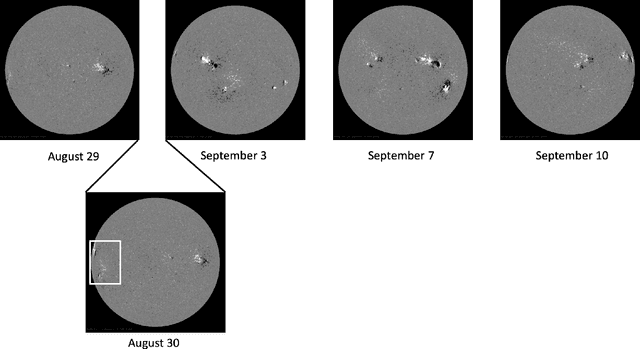
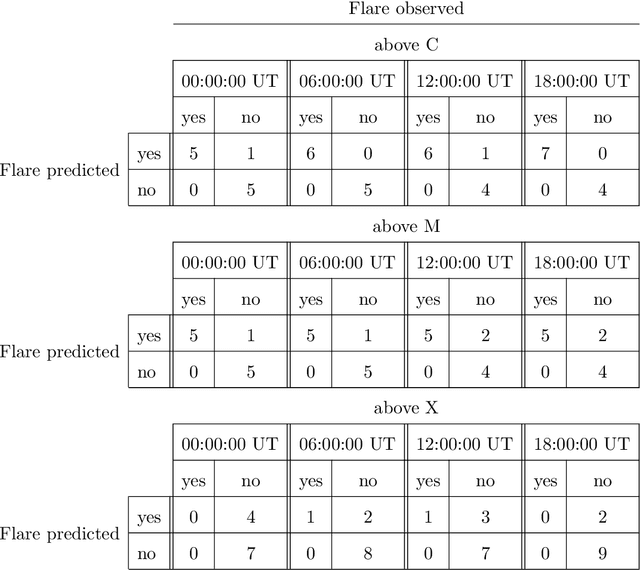
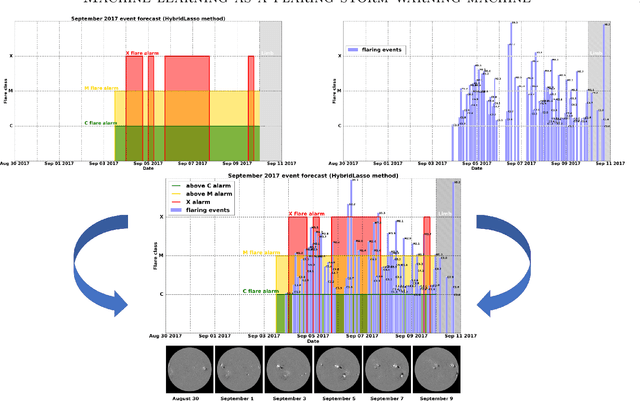
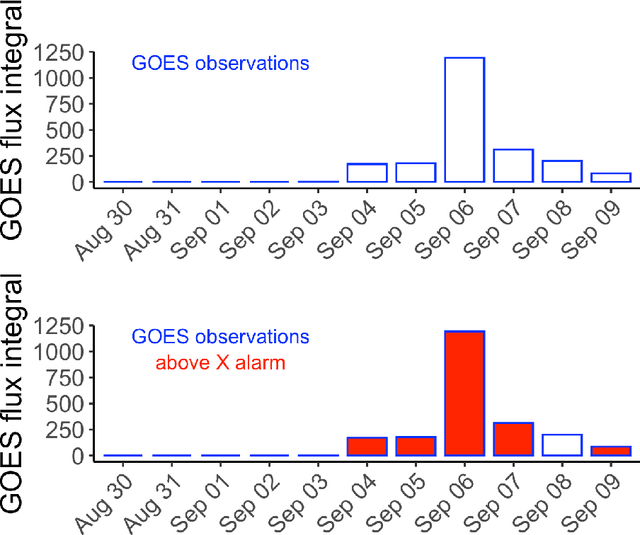
Abstract:Machine learning is nowadays the methodology of choice for flare forecasting and supervised techniques, in both their traditional and deep versions, are becoming the most frequently used ones for prediction in this area of space weather. Yet, machine learning has not been able so far to realize an operating warning system for flaring storms and the scientific literature of the last decade suggests that its performances in the prediction of intense solar flares are not optimal. The main difficulties related to forecasting solar flaring storms are probably two. First, most methods are conceived to provide probabilistic predictions and not to send binary yes/no indications on the consecutive occurrence of flares along an extended time range. Second, flaring storms are typically characterized by the explosion of high energy events, which are seldom recorded in the databases of space missions; as a consequence, supervised methods are trained on very imbalanced historical sets, which makes them particularly ineffective for the forecasting of intense flares. Yet, in this study we show that supervised machine learning could be utilized in a way to send timely warnings about the most violent and most unexpected flaring event of the last decade, and even to predict with some accuracy the energy budget daily released by magnetic reconnection during the whole time course of the storm. Further, we show that the combination of sparsity-enhancing machine learning and feature ranking could allow the identification of the prominent role that energy played as an Active Region property in the forecasting process.
MEM_GE: a new maximum entropy method for image reconstruction from solar X-ray visibilities
Feb 18, 2020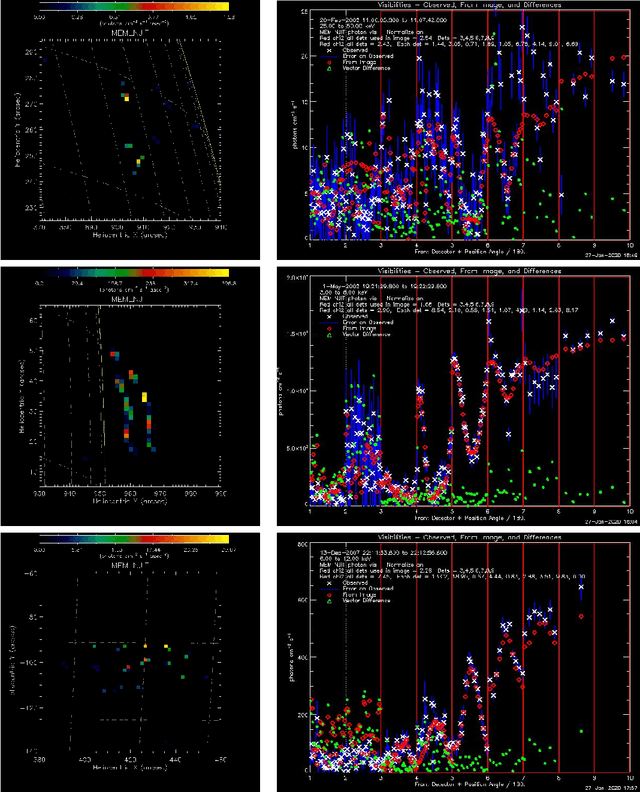
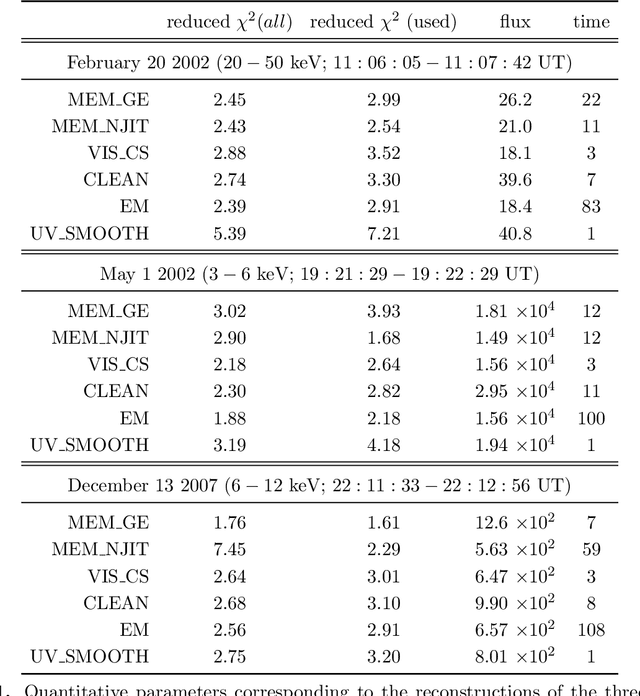

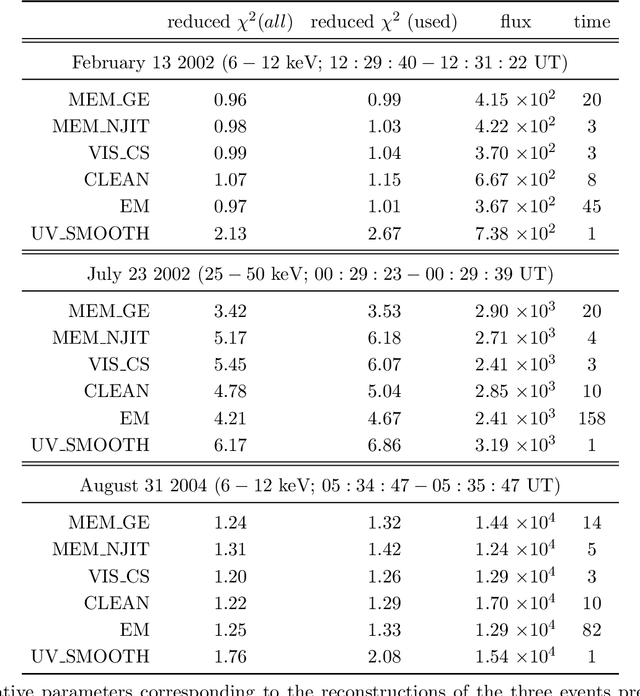
Abstract:Maximum Entropy is an image reconstruction method conceived to image a sparsely occupied field of view and therefore particularly appropriate to achieve super-resolution effects. Although widely used in image deconvolution, this method has been formulated in radio astronomy for the analysis of observations in the spatial frequency domain, and an Interactive Data Language (IDL) code has been implemented for image reconstruction from solar X-ray Fourier data. However, this code relies on a non-convex formulation of the constrained optimization problem addressed by the Maximum Entropy approach and this sometimes results in unreliable reconstructions characterized by unphysical shrinking effects. This paper introduces a new approach to Maximum Entropy based on the constrained minimization of a convex functional. In the case of observations recorded by the Reuven Ramaty High Energy Solar Spectroscopic Imager (RHESSI), the resulting code provides the same super-resolution effects of the previous algorithm, while working properly also when that code produces unphysical reconstructions. Results are also provided of testing the algorithm with synthetic data simulating observations of the Spectrometer/Telescope for Imaging X-rays (STIX) in Solar Orbiter. The new code is available in the {\em{HESSI}} folder of the Solar SoftWare (SSW)tree.
Desaturating EUV observations of solar flaring storms
Apr 08, 2019
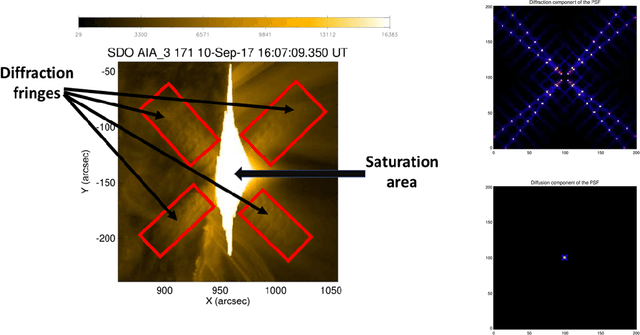
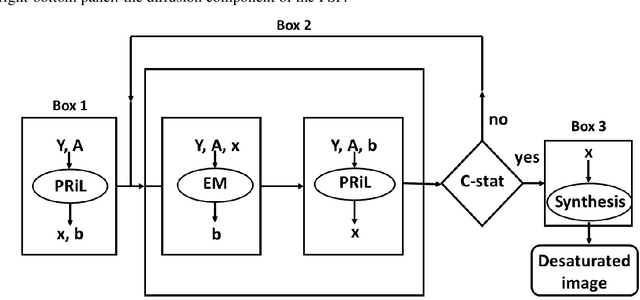
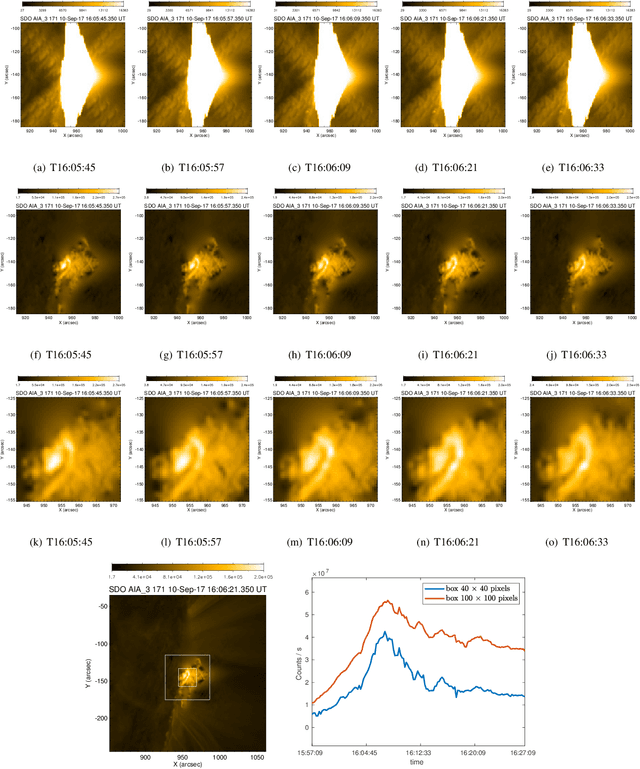
Abstract:Image saturation has been an issue for several instruments in solar astronomy, mainly at EUV wavelengths. However, with the launch of the Atmospheric Imaging Assembly (AIA) as part of the payload of the Solar Dynamic Observatory (SDO) image saturation has become a big data issue, involving around 10^$ frames of the impressive dataset this beautiful telescope has been providing every year since February 2010. This paper introduces a novel desaturation method, which is able to recover the signal in the saturated region of any AIA image by exploiting no other information but the one contained in the image itself. This peculiar methodological property, jointly with the unprecedented statistical reliability of the desaturated images, could make this algorithm the perfect tool for the realization of a reconstruction pipeline for AIA data, able to work properly even in the case of long-lasting, very energetic flaring events.
Geometry of the Hough transforms with applications to synthetic data
Apr 04, 2019
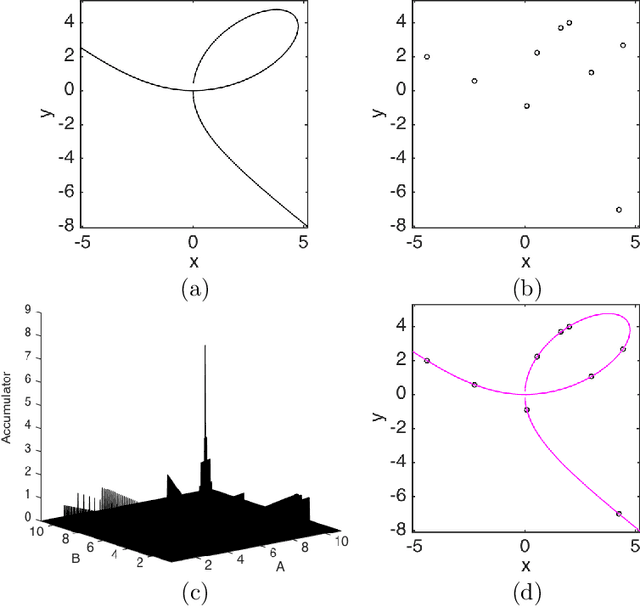

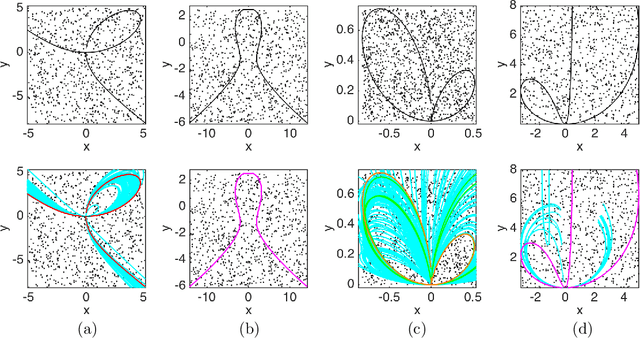
Abstract:In the framework of the Hough transform technique to detect curves in images, we provide a bound for the number of Hough transforms to be considered for a successful optimization of the accumulator function in the recognition algorithm. Such a bound is consequence of geometrical arguments. We also show the robustness of the results when applied to synthetic datasets strongly perturbed by noise. An algebraic approach, discussed in the appendix, leads to a better bound of theoretical interest in the exact case.
A hybrid supervised/unsupervised machine learning approach to solar flare prediction
Jun 21, 2017



Abstract:We introduce a hybrid approach to solar flare prediction, whereby a supervised regularization method is used to realize feature importance and an unsupervised clustering method is used to realize the binary flare/no-flare decision. The approach is validated against NOAA SWPC data.
 Add to Chrome
Add to Chrome Add to Firefox
Add to Firefox Add to Edge
Add to Edge